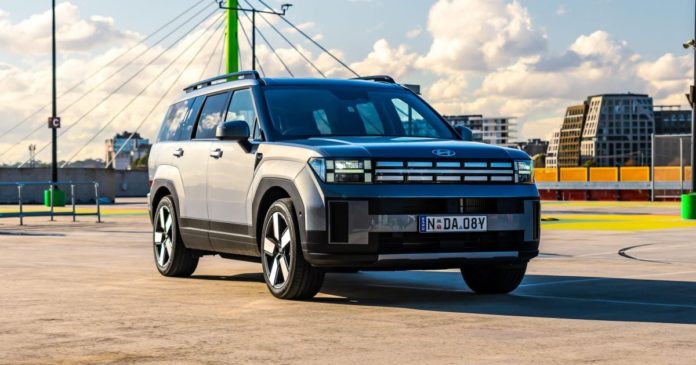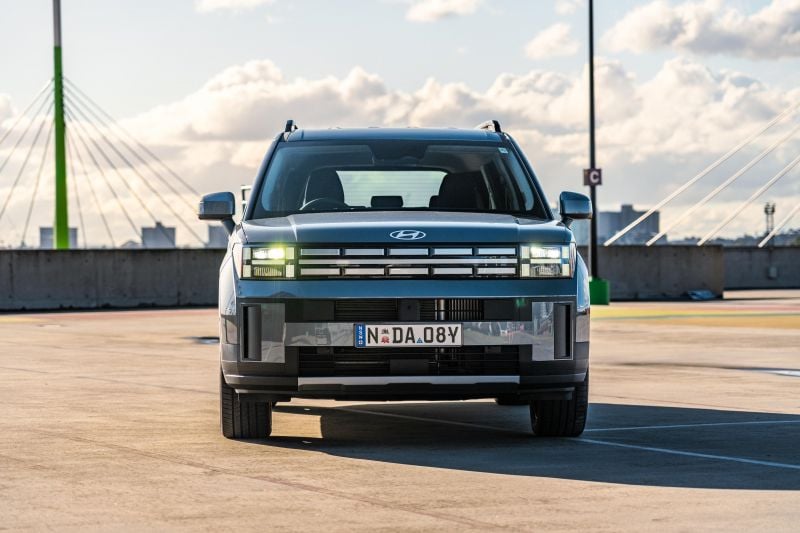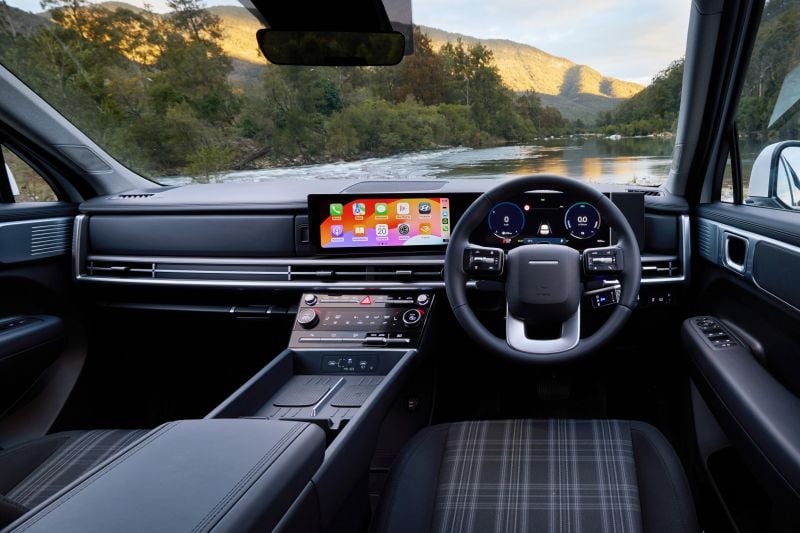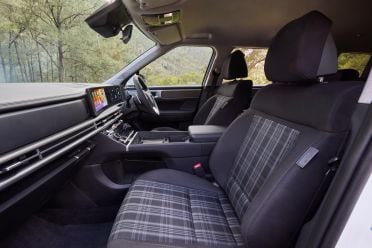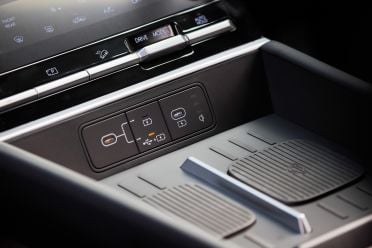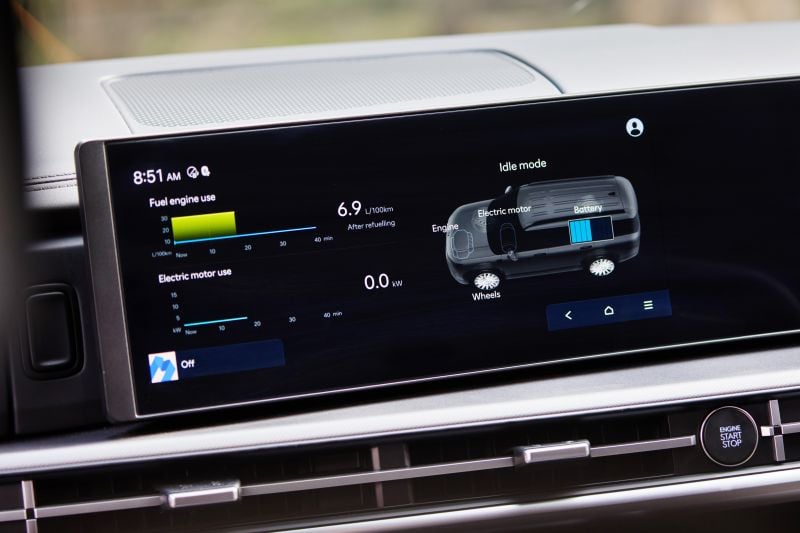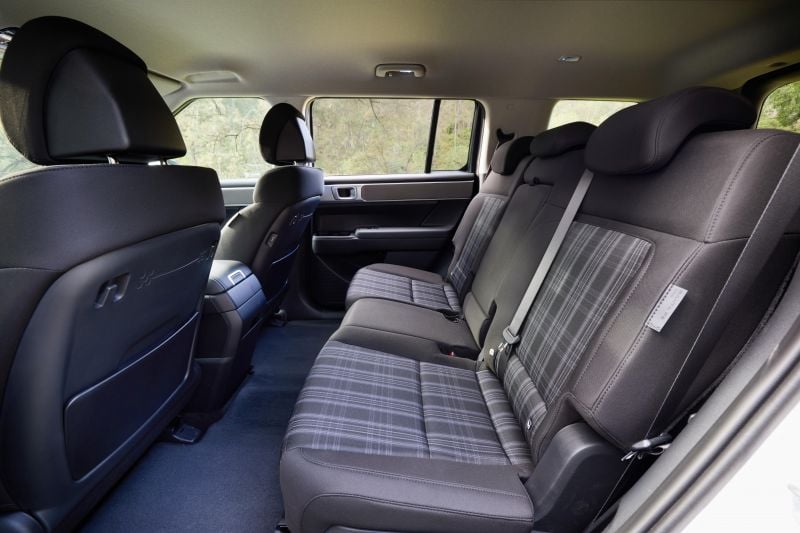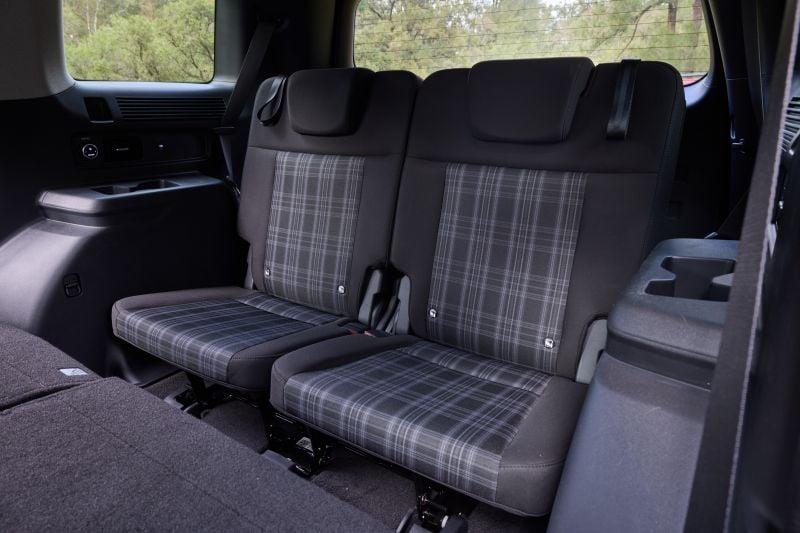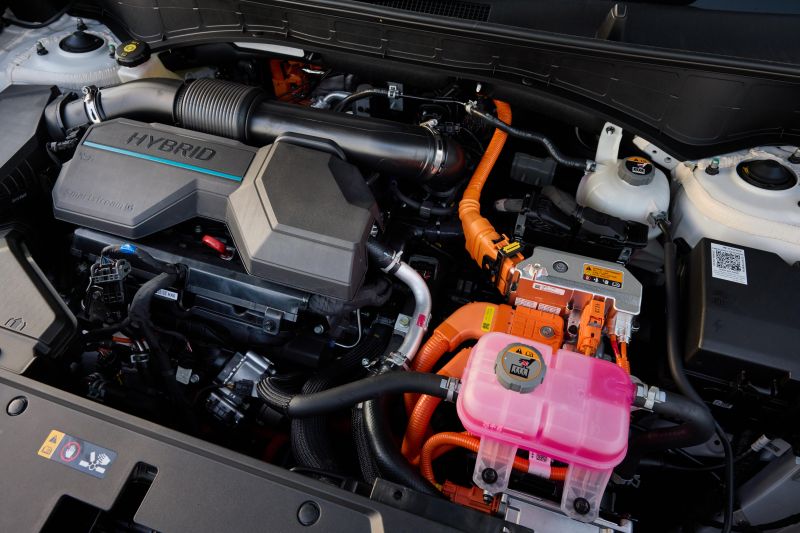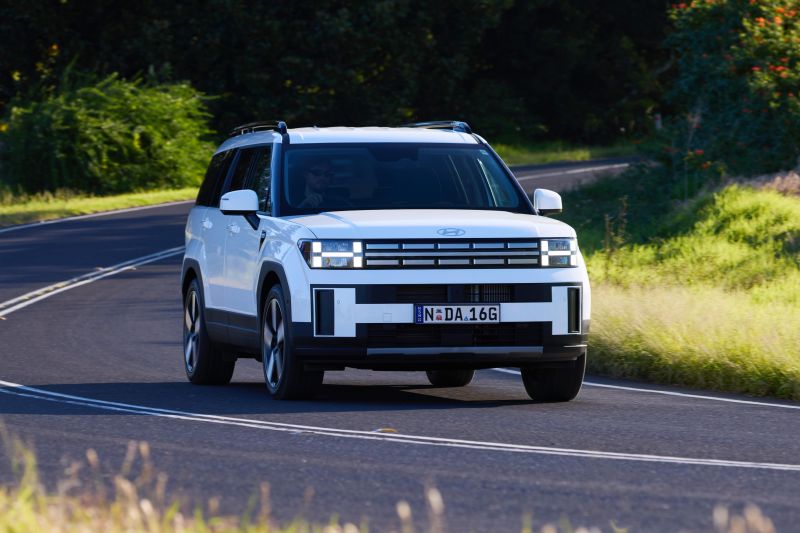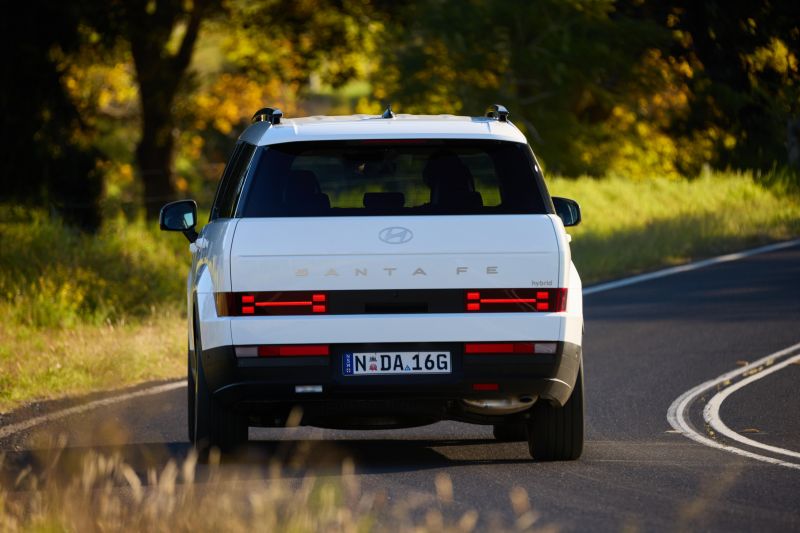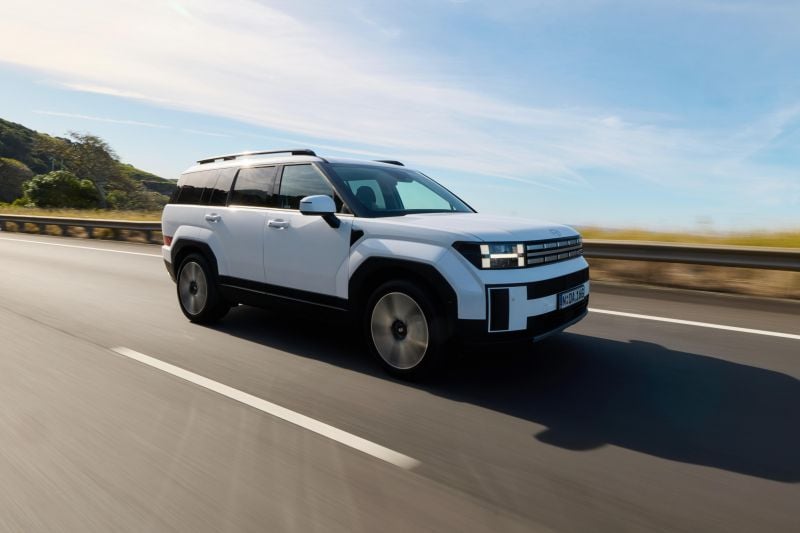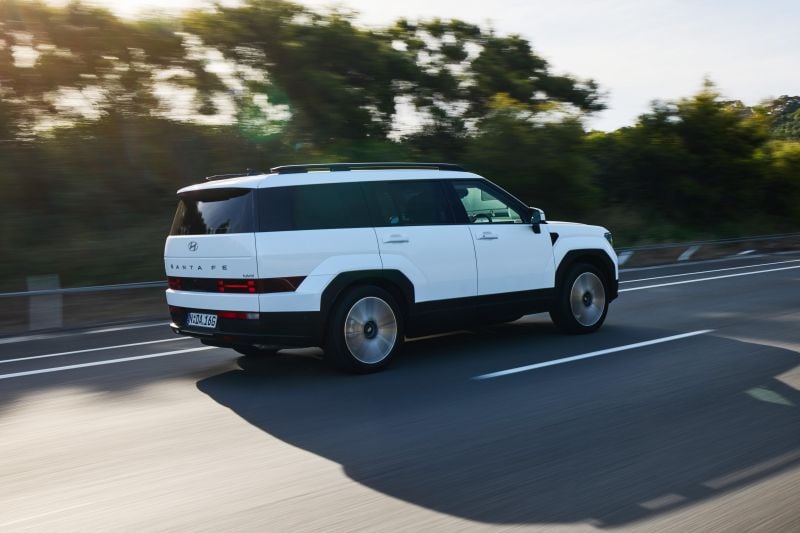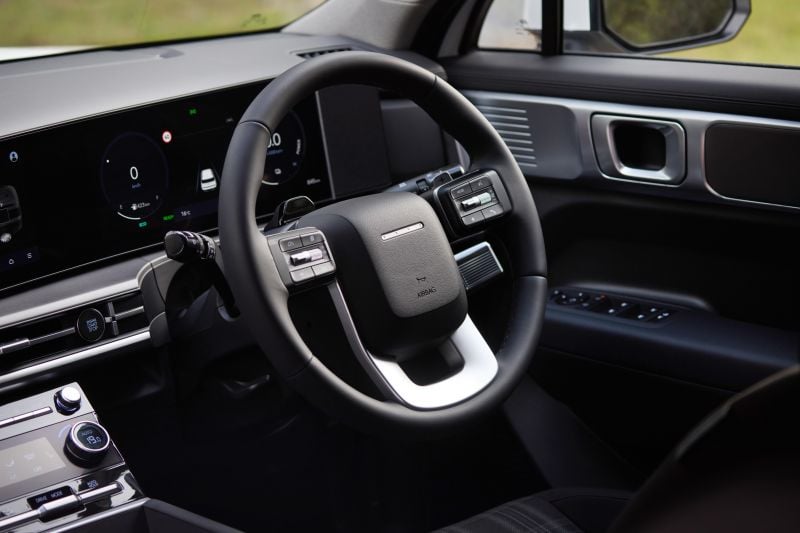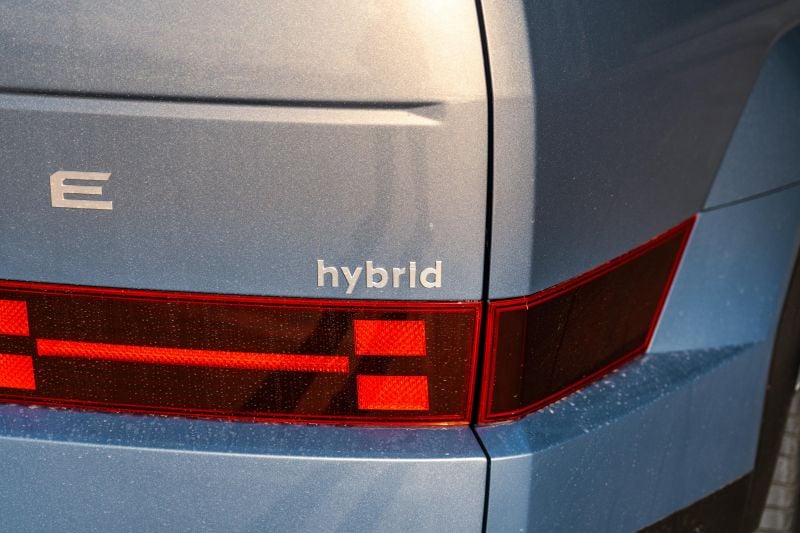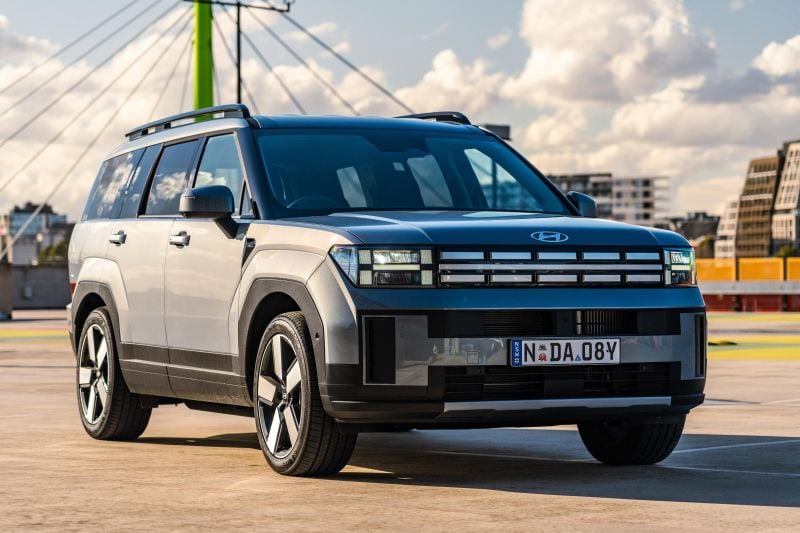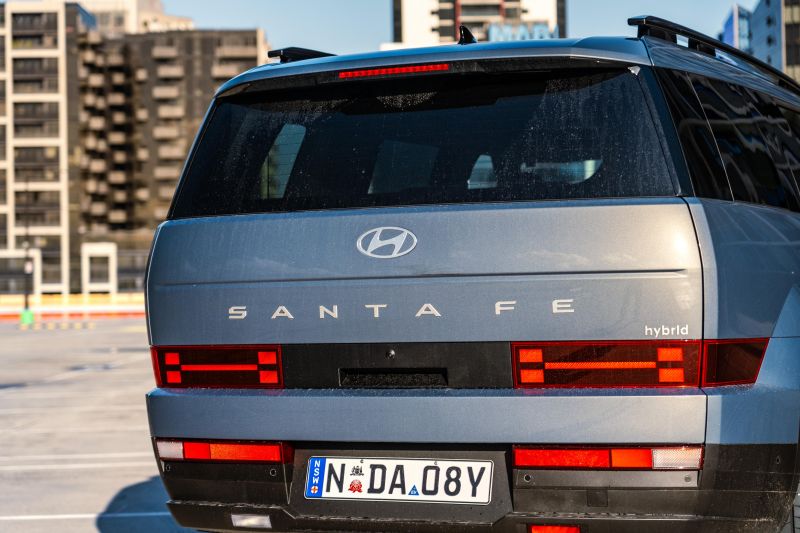It’s a Discovery, it’s a Defender, it’s a… Hyundai?!
The latest Hyundai Santa Fe is a massive design departure from its more curvaceous predecessors, presenting boxy Land Rover-aping lines and distinctive LED lighting signatures.
While it’s not as classically handsome as some generations before it, the new Santa Fe is as practical and tech-laden as ever, aiming to bridge the gap between the H brand and its top-rating sister car, the Kia Sorento.
Hyundai Australia decided to launch with a hybrid-only lineup for the new Santa Fe, doing away with the outgoing model’s V6 petrol and four-cylinder turbo-diesel powertrain options. A powerful turbocharged petrol four-cylinder will join the fold in the new year, the company’s local arm tells us.
So, in an effort to cash in on increasing hybrid demand and compete with sales leader Toyota, Hyundai has gone hard on HEV and brought no less than five electrified variations of its new seven-seater family SUV.
On test here is the most affordable Santa Fe Hybrid FWD, a cloth-trimmed, contrast-bumpered entry model that packs in a stack of features and tech for just over $55,000. Really, you could choose between this or a smaller Tucson.
But while it might look very compelling on paper, is Hyundai’s new Minecraft-styled family bus worth your consideration over the aforementioned Sorento or the now hybrid-only Toyota Kluger? Read on to find out.
How does the Hyundai Santa Fe compare?
View a detailed breakdown of the Hyundai Santa Fe against similarly sized vehicles.

Hyundai
Santa Fe
How much does the Hyundai Santa Fe cost?
The sole front-drive Santa Fe is the cheapest on sale, priced from $55,500 plus on-road costs.
| Model | Price before on-road costs |
|---|---|
| Hyundai Santa Fe Hybrid FWD | $55,500 |
| Hyundai Santa Fe Hybrid AWD | $58,500 |
| Hyundai Santa Fe Hybrid Elite AWD | $65,000 |
| Hyundai Santa Fe Hybrid Calligraphy AWD 7 Seat | $75,000 |
| Hyundai Santa Fe Hybrid Calligraphy AWD 6 Seat | $75,500 |
To see how the Santa Fe Hybrid lines up against the competition, check out our comparison tool.
What is the Hyundai Santa Fe like on the inside?
You hardly feel like you’re hopping into a basey here.
Yes, the tartan-style cloth trim is a giveaway that this isn’t luxury spec – though it’s a little GTI-esque – but there are still nice trim flourishes, soft-touch materials and a high level of technology.
Unlike Kia, Hyundai has specified the high-end 12.3-inch digital instrument cluster as standard equipment, sitting alongside the high-grade 12.3-inch central touchscreen in a single curved housing. It’s quite swish in design.
While the base grade misses out on native satellite navigation, it’s fitted as standard with wireless Apple CarPlay and Android Auto, over-the-air (OTA) software updates, and Bluelink connected services.
The Koreans have really kept the Japanese honest in display technology in the mainstream classes, and the Santa Fe remains at the forefront of the segment here too – particularly for the price point.
Even in this base grade the driver’s seat is 10-way power adjustable and there’s an honesty about the cloth trim with tartan inserts that’s quite endearing. They’re better at escaping extreme cold or heat than leather, too, and even these base cloth pews are heated.
It’s easy to get comfortable and there’s a real feeling of airiness and space thanks to that tall and boxy design. Once you find your preferred driving position, it’s very comfortable and everything is within arm’s reach.
During my time with the base Santa Fe, the wireless Apple CarPlay worked beautifully with my iPhone 15 Pro Max, bar one time when it didn’t connect on start-up, and the pedestal-style wireless phone charger was more consistent than in some other brands.
In addition to the usual interface and menus as part of Hyundai and Kia’s latest ccNC infotainment architecture, there are hybrid-specific menus with energy flow charts and efficiency graphics to better track your fuel economy and hybrid power usage should you so wish.
The digitised climate control cluster looks very new-age while also being pretty functional, with physical dials and switchgear for key functions and displaying information on the 6.6-inch touch panel – very Genesis-like.
Dual-zone climate control with rear air vents and separate fan controls for the third row are standard. Really, unless you want the look and fancier luxuries of higher grades, this base car has everything you will ever need and then some.
Fun extras include the upper glovebox cavity for phones and wallets, though it does without the UV cleaner in higher grades. There’s also a lower open shelf for similarly sized items.
Then there’s the configurable centre console, with USB-C charging ports, cup holders and a cubby under the centre armrest. You even get a cavity under the centre bridge thanks to the shift-by-wire selector being moved to the steering column like the brand’s new EVs.
Perhaps moreso than the front, the second row has benefitted from the new boxy body styling. There’s heaps of space for adults in the rear, even in the centre seat which is helped by a flat floor.
The rear bench slides and reclines, and there’s a one-touch control to access the third row. Further, there are additional USB-C power outlets and various amenities even in this base grade.
Bag hooks and map pockets adorn the backs of the front seats, and there are bottle holders in the doors in addition to a folding centre armrest with cupholders.
If you’re looking to carry smaller children, there are ISOFIX anchors on the outer seats as well as top tethers for all three rear positions.
Got triplets? Quadruplets? Well, there are ISOFIX anchors on the sixth and seventh seats bolstered by top tethers, and the Santa Fe has full airbag coverage through all three rows for peace of mind.
Third-row occupants aren’t treated to the same soft-touch surfaces of the first two rows, but the armrests on either side have integrated cupholders and as mentioned earlier there are separate fan controls for the rearmost vents.
Each of the third-row seats are individually folding and reclinable, with adjustable head restraints. While my 6’1 frame isn’t the primary demographic for this third row, I could squeeze myself in there for a shorter journey if need be.
Kids will be pretty happy back there with a good view out of those big, square quarter windows. It’s arguably somewhere between the Sorento and larger Palisade in terms of third-row accommodation these days.
Hyundai quotes 628 litres (VDA) of cargo capacity with the first two rows in use, expanding to 1949 litres with rows two and three folded. For reference, the old Santa Fe offered 571-1649 litres in the same configurations.
On top of the extra space, all versions of the new-generation Santa Fe Hybrid feature full-size spare wheels.
| Dimensions | Hyundai Santa Fe Hybrid |
|---|---|
| Length | 4830mm |
| Width | 1900mm |
| Height | 1720mm |
| Wheelbase | 2815mm |
| Boot space | 628L – 5 seats 1949L – 2 seats |
To see how the Santa Fe Hybrid lines up against the competition, check out our comparison tool.
What’s under the bonnet?
The Santa Fe Hybrid has an updated version of the 1.6-litre turbocharged hybrid drivetrain used across a variety of Hyundai-Kia models, which now offers more power and torque.
| Specifications | Hyundai Santa Fe Hybrid FWD |
|---|---|
| Engine | 1.6L 4cyl turbo HEV |
| Engine outputs | 132kW / 265Nm |
| Electric motor outputs | 44.2kW / 264Nm |
| System outputs | 172kW @ 5600rpm 367Nm @ 1000-4100rpm |
| Battery | 1.49kWh li-ion |
| Transmission | 6-speed auto |
| Driven wheels | Front |
| Weight | 1951kg |
| Fuel economy (claimed) | 5.4L/100km |
| Fuel economy (as tested) | 6.2L/100km |
| Fuel tank capacity | 67 litres |
| Fuel requirement | 91 RON |
| CO2 emissions | 128g/km |
| Emissions standard | Euro 5 |
| Braked tow capacity | 1650kg |
To see how the Santa Fe Hybrid lines up against the competition, check out our comparison tool.
How does the Hyundai Santa Fe drive?
I’ve had plenty of wheel time with the Hyundai Motor Group’s hybrids, but this Santa Fe is a step forward.
Having recently stepped out of the related Sorento Hybrid, which uses an older version of the same drivetrain, the Hyundai feels like it has had an extra layer of polish applied to the driving experience.
In most areas it’s a smoother and more refined car, with good assistance from the electric motor at low speeds and at a cruise, while the 1.6-litre turbo-petrol engine avoids the buzziness and coarse revving that it has in applications past.
Despite now measuring over 4.8m long and weighing more than 1.9 tonnes, the Santa Fe Hybrid offers decent shove for daily duties thanks to the immediacy of the electric motor’s torque, and the smooth-shifting six-speed auto.
You’re probably not going to win many traffic light drag races – but is that really what this is about? I’d say not.
It can sometimes be difficult to gauge how the vehicle will respond, though. While the Santa Fe HEV is more than capable of getting up to city speeds on EV power alone, it will often be inconsistent in this respect.
Sometimes it’ll do mostly EV off the mark, others it will fire up the ICE very early in the process. Other times, it can be somewhere in between. This isn’t so much of an issue per se, but it also can mean the Santa Fe isn’t as consistent in the experience or fuel economy as the excellently efficient Kluger Hybrid.
That was reflected in our real-world figure too, which at 6.2L/100km indicated after a week’s worth of mixed driving is good but not standout. Still, it’s far better than the old V6 and is probably better than what the previous diesel sans idle stop/start tech would manage with more peak-hour city commuting.
A common complaint with this turbocharged hybrid system is the lack of a taller final gear, with the six-speed auto keeping the 1.6 T-GDI motor revving around the 2000rpm mark at 100 clicks. A seventh or eighth cog to bring this down a little would help with highway consumption, which very quickly approaches the 7.0L/100km mark.
Beyond that the Santa Fe is a very comfortable and refined place to spend time in. The ride even on 20-inch wheels is well sorted and pliant over Melbourne’s lumpy city streets, and the electrified drivetrain’s tendency to regularly switch off the petrol engine makes for a pretty quiet cabin on the move.
It’s not quite whisper-quiet, with rougher sections of black top on higher-speed roads letting a little more road noise in than properly premium alternatives, while the bluff and boxy sides mean there’s occasionally some wind noise too.
The Santa Fe’s steering, handling and body control are also good for the class, with accurate driver controls and balanced handling that focuses on comfort more so than engaging dynamics. Still, it’s not wallowy or vague to drive.
We didn’t get the chance to load up the Santa Fe with six additional bums on seats and trial its characteristics closer to payload, but with a couple of extras on board it felt more than up to task, particularly in the sort of urban and city scenarios most owners will be using this for.
Hyundai’s suite of driver assists are also good, benefitting from refinements since some of the earlier and more annoying iterations first hit the market – a shortcut to disable the audible speed warning is being rolled out now.
The base Santa Fe doesn’t feature the semi-autonomous Highway Driving Assist (HDA) feature that’s available on higher-grade and navigation-equipped models, but the standard adaptive cruise and Lane Following Assist (centring) functions work reliably and accurately – tick.
Blind-spot assist and rear cross-traffic assist both work as you’d expect, and the standard surround-view cameras with 3D modelling mean you have numerous sets of eyes to ensure you’re not knocking into things or pedestrians, or curbing those 20-inch machine-faced rims.
For an entry-level variant, the on-road experience is pretty high-grade.
What do you get?
Santa Fe standard equipment:
- 20-inch alloy wheels
- LED headlights
- Auto high-beam
- Proximity entry with push-button start
- Electronic parking brake with auto hold function
- 3 x drive modes – Eco, Sport, My Drive
- 3 x multi-terrain drive modes – AWD only
- Dual-zone climate control
- 10-way power-adjustable driver’s seat
- Obsidian Black cloth upholstery
- Leather-wrapped steering wheel
- 12.3-inch digital instrument cluster
- 12.3-inch infotainment touchscreen
- Over the air (OTA) software updates
- Apple CarPlay, Android Auto – wireless, wired
- Wireless smartphone charger
- Surround-view camera system
- 6-speaker sound system
- Heated front seats
- Power tailgate
- Rear privacy glass
- Full-size alloy spare wheel
Santa Fe Elite adds:
- Silver exterior highlights
- Remote Smart Parking Assist
- Black leather seats
- Suede headlining
- 10-way power-adjustable passenger seat
- Heated steering wheel
- Bose premium audio system – 12 speakers
- Dual wireless smartphone charger
- Bluelink connected services
- Auto-dimming rearview mirror
Santa Fe Calligraphy adds:
- Unique 20-inch wheels
- Glass sunroof
- Head-up display
- Digital camera rearview mirror
- Black Ink Nappa leather upholstery
- Relaxation function – front seats
- Memory function – front seats, mirrors
- Heated outboard second-row seats
- Ventilated front seats
- UV-C sanitisation tray
- UV and infrared insulated windscreen, front windows
The Calligraphy is also offered with a six-seat layout with second-row electrically adjustable captain’s chairs, which might offer a more plush experience but may limit practicality somewhat.
Is the Hyundai Santa Fe safe?
The new-generation Santa Fe remains unrated by ANCAP and Euro NCAP.
Standard safety features across the range include:
- 10 airbags
- Autonomous emergency braking (AEB)
- Pedestrian, Cyclist detection
- Junction assist
- Adaptive cruise control with stop and go
- Blind-spot assist
- Blind Spot View Monitor
- Driver attention warning
- Forward attention warning
- Leading vehicle departure alert
- Evasive steering assist function
- Intelligent speed limit assist
- Lane Following Assist
- Lane keep assist
- Parking Collision Avoidance Assist
- Rear cross-traffic assist
- Rear occupant alert
- Safe exit assist
- Front, rear parking sensors
- Surround-view monitor – 360 cameras
How much does the Hyundai Santa Fe cost to run?
Hyundai covers its range with a five-year, unlimited-kilometre warranty, while the high-voltage battery and electric motor componentry of the hybrid system is covered for eight years or 160,000km.
| Running costs | Hyundai Santa Fe Hybrid |
|---|---|
| Warranty | 5 years, unlimited kilometres (vehicle) 8 years or 160,000km (HV battery) |
| Roadside assistance | 12 months, then service activated (lifetime) |
| Service intervals | 12 months or 10,000 kilometres |
| Capped-price servicing | 5 years – pre-paid |
| Total capped-price service cost | $2405 |
Hyundai still disappointingly limits its service intervals to 10,000km (or 12 months) for its turbocharged petrol models, much like sister brand Kia. Still, Hyundai has done better to limit service costs by comparison.
With a pre-paid package available for $2405 over five years, the Santa Fe costs less than $500 per annum to maintain over the first five years of ownership, which is not quite Toyota Kluger good but not bad in the scheme of things.
To see how the Santa Fe Hybrid lines up against the competition, check out our comparison tool.
CarExpert’s Take on the Hyundai Santa Fe
This new Santa Fe can be a considered a new benchmark – though I feel its looks might be its biggest hurdle.
Even in this most basic grade, the Santa Fe Hybrid offers everything a growing Australian family needs and then some. Similar money won’t buy you a Toyota Kluger Hybrid either, and the $5000-dearer base GX AWD feels like a fleet spec.
If anything, this entry-level model is priced and specified to tempt people out of mid- to high-spec mid-size alternatives like the RAV4 and even Hyundai’s own Tucson. And, it’s a far better seven-seater than a Mitsubishi Outlander Plug-in Hybrid EV (PHEV).
The Santa Fe Hybrid is very well rounded. It’s spacious, well-featured, relatively efficient and offers good on-road performance. Hyundai’s aftersales program is likewise in line with rivals, so there’s plenty to love.
Drawbacks? It’s not quite as efficient as a Toyota Kluger Hybrid, the looks are sure to polarise and the cloth trim, while fetching, isn’t as family friendly as leatherette or genuine hide. But really, there’s not much else to complain about.
If you’re in the market for a large seven-seat SUV, this should be towards the top of your shopping list.
Interested in buying a Hyundai Santa Fe? Get in touch with one of CarExpert’s trusted dealers here
Click the images for the full gallery
MORE: Everything Hyundai Santa Fe

